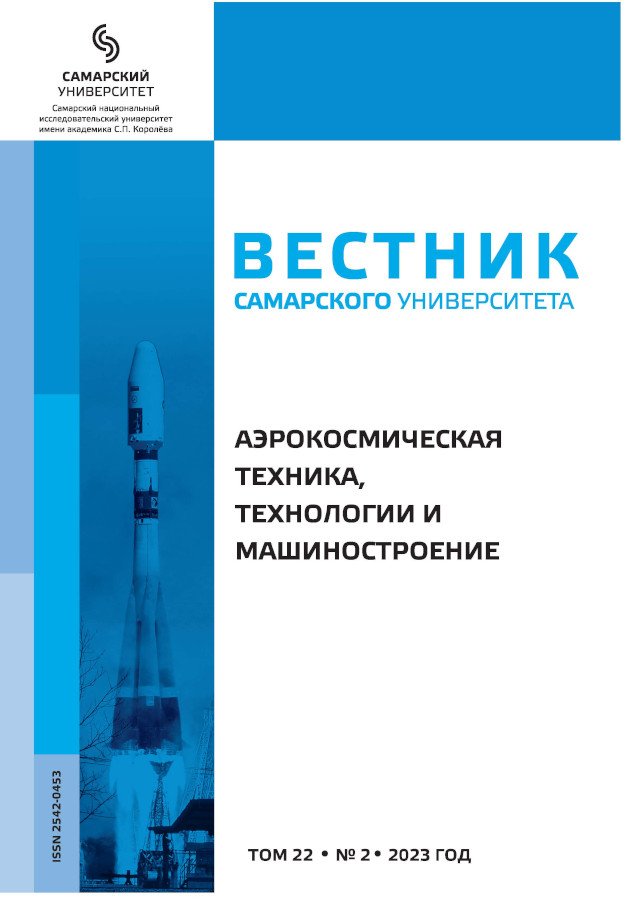Simulating the process of retargeting of optoelectronic Earth observation spacecraft during object shooting
- Authors: Kurenkov V.I.1, Pupkov E.A.1, Kucherov A.S.1
-
Affiliations:
- Samara National Research University
- Issue: Vol 22, No 2 (2023)
- Pages: 7-20
- Section: AIRCRAFT AND SPACE ROCKET ENGINEERING
- URL: https://journals.ssau.ru/vestnik/article/view/23121
- DOI: https://doi.org/10.18287/2541-7533-2023-22-2-7-20
- ID: 23121
Cite item
Full Text
Abstract
Design models and algorithms have been developed to estimate the spatial direction of the reorientation of spacecraft for optoelectronic observation of the Earth’s surface during object shooting, taking into account the relative movement of the surveillance objects in the field of view of the spacecraft. Modeling is simplified due to the choice of such coordinate systems in which the spacecraft is stationary and the surveillance objects move relative to it. The direction of rotation of the spacecraft with a given angular velocity is found at the point of the upcoming intersection of the optical axis of the observation equipment on the Earth’s surface with the surveillance object moving in the selected coordinate system. The models and algorithms were developed in order to expand the capabilities of Samara University’s existing software package for evaluating the target indicators and design characteristics of observation spacecraft. Based on the developed re-targeting models, algorithms have been developed for selecting the sequence of shooting observation objects according to the criterion of their maximum number on the orbit of the spacecraft flight and counting the captured objects to assess the performance of survey. An example of the implementation of one of the graphic windows of the software with the developed models and algorithms is given, in which the process of re-targeting the spacecraft is visualized, which is one of the ways to verify the adequacy of the developed models and algorithms.
About the authors
V. I. Kurenkov
Samara National Research University
Author for correspondence.
Email: kvi.48@mail.ru
Doctor of Science (Engineering), Professor of the Department of Space Engineering
Russian FederationE. A. Pupkov
Samara National Research University
Email: zuce@mail.ru
Senior Lecturer of the Department of Space Engineering
Russian FederationA. S. Kucherov
Samara National Research University
Email: alexandersk@mail.ru
Candidate of Science (Engineering), Associate Professor of the Department of Space Engineering
Russian FederationReferences
- Galkina A.S., Manturov A.I., Rublev V.I., Yurin V.E. Analyzing the level of accuracy in creating and implementing computer programs for controlling a space vehicle’s angular movement using systems of satellite navigation. Gyroscopy and Navigation. 2010. V. 1, Iss. 3. P. 155-162. doi: 10.1134/S2075108710030016
- Gorelov Yu.N., Kurganskaya L.V., Manturov A.I., Sollogub A.V., Yurin V.E. On optimization of attitude control programs for Earth remote sensing satellite. Gyroscopy and Navigation. 2014. V. 5, Iss. 2. P. 90-97. doi: 10.1134/S2075108714020035
- Somov Ye.I., Butyrin S.A., Somova T.Ye. Autonomous guidance and attitude control of a spacecraft in tracking mode. Izvestiya Samarskogo Nauchnogo Tsentra RAN. 2019. V. 21, no. 5 (91). P. 96-107. (In Russ.)
- Kurenkov V.I. Osnovy proektirovaniya kosmicheskikh apparatov optiko-elektronnogo nablyudeniya poverkhnosti Zemli. Raschet osnovnykh kharakteristik i formirovanie proektnogo oblika: ucheb. posobie [Fundamentals of the design of spacecraft for optoelectronic observation of the Earth’s surface. Calculation of the main characteristics and conceptual design: textbook]. Samara: Samara University Publ., 2020. 461 p.
- Kurenkov V.I., Salmin V.V., Abramov B.A. Modelirovanie tselevogo funktsionirovaniya kosmicheskikh apparatov nablyudeniya s uchetom energobalansa: ucheb. posobie [Modeling of target functioning of observation spacecraft taking into account the energy balance: manual]. Samara: Samara State Aerospace University Publ., 2007. 160 p.
Supplementary files






















